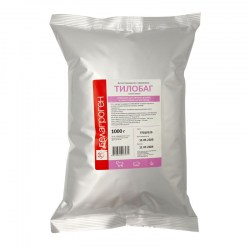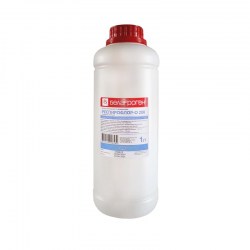Tylobag
Veterinary drug TILOBAG
Treatment of bacterial infections in young cattle, pigs, and poultry
- A broad spectrum of antimicrobial action
- Highly effective against mycoplasma
- Well absorbed in the gastrointestinal tract
- A therapeutic concentration in the blood is reached within 2 hours after the drug administration
Therapeutic indications:
The drug is used in young cattle, pigs and poultry (broiler chickens, young replacement chickens, parent flock and turkey) for the treatment of bacterial diseases caused by tylosin-sensitive microorganisms:
- respiratory mycoplasmosis in animals and poultry;
- infectious sinusitis and synovitis in turkey;
- arthritis;
- erysipelas in pigs;
- dysentery and gastroenterocolitis of bacterial etiology in pigs;
- ileitis, or proliferative adenomatosis in pigs;
- bronchopneumonia in calves and others.
Composition of the veterinary drug:
1 g of the drug contains:
- 900,000 IU of tylosin tartrate as an active substance, which corresponds to 970 mg tylosin tartrate.
Pharmacological activity:
TILOBAG is an antibacterial drug. Tylosin tartrate, which is the active substance of the drug, is an antibiotic of the macrolide group.
Tylosin tartrate has bacteriostatic effect and acts against most gram-positive and some gram-negative microorganisms, including: Staphylococcus spp., Streptococcus spp., Diplococcus spp. Corynebacterium spp., Clostridium spp., Erysipelothrix rhusiopathiae, Moraxella bovis, Klebsiella spp., Fusobacterium spp., Bordetella bronchiseptica, Haemophilus spp., Pasteurella spp., Rickettsia spp., Chlamydia spp. Mycoplasmas (Mycoplasma gallisepticum, Mycoplasma meleagridis, Mycoplasma synoviae, Mycoplasma arthritidis, Mycoplasma hyosynoviae, Mycoplasma bovis, Mycoplasma suipneumoniae u Mycoplasma hyorhinis) are highly sensitive to tylosin.
Tylosin reversibly binds to the 50S ribosomal subunit that leads to the biochemical processes inhibition and the protein biosynthesis suppression in the microbial cell thus revealing tylosin’s bacteriostatic effect.
Being administered orally, the antibiotic is well absorbed from the gastrointestinal tract. A therapeutic concentration of tylosin tartrate in the tissues is reached after 2 hours after the drug administrartion.
The maximum concentration of tylosin is found in the lungs, liver, mammary gland and kidneys. Being administered at a single dose, the therapeutic concentration of the antibiotic in the blood is maintained for 15-18 hours. Tylosin is excreted from the body mainly with faeces, and to a lesser extent with urine and milk.
Dosage:
The drug is used in animals and poultry:
- calves administered individually orally with food or drinking water at a dose of 5-10 mg of the drug per 1 kg of body weight of the animal, 2 times a day, until the affected animal completely recover (5-10 days);
- pigs administered individually or in herd orally at a dose of 10–20 mg of drug per 1 kg of body weight for 3-5 days;
- poultry administered at a dose of 0.4 g of the drug per 1 liter of drinking water or 0.1 g of the drug per 1 kg of body weight before 3 weeks of age and 0.08 g of the drug per 1 kg of body weight after 3 weeks of age for 3-5 days, depending on the severity of the disease.
Animals and poultry should receive only water containing the drug during the treatment period.
The working solution of the drug should be prepared on a daily basis depending on the daily requirements of animals and poultry in drinking water.
Precautions and adverse reactions:
When using the drug in accordance with this instruction, side effects and complications generally are not observed. When given to pigs, sometimes, allergic reactions such as erythema and itching rarely may be observed after the drug administration. These symptoms disappear naturally after cancellation of the drug.
In case of side effects, the drug should be cancelled; antihistamines, symptomatic treatemnt are prescribed, if necessary.
Do not use in animals with hypersensitivity to the components of the drug.
After the first administration no peculiarities are revealed.
In case of an overdose, side effects such as loss of appetite, gastrointestinal tract disorder may be observed. In this case, the drug treatment should be cancelled and, if necessary, symptomatic therapy is conducted.
Avoid missing the next dose of the drug, as it may lead to the reduced therapeutic effect. If administration of the veterinary drug is missed, resume it in the same dosage and according to the same treatment scheme as soon as possible.
Do not use the drug simultaneously with antibiotics of penicillin and cephalosporin groups, lyncosamides (clindamycin, lyncomycin) and rifampicin.
Do not use the drug simultaneously with bentonite as it leads to the reduced therapeutic effect of the drug.
Tylosine has a broad spectrum of compatibility with other drugs: tylosine potentiates the spiramycin, tetracycline and erythromycin action; tylosine is compatible with sulfonamides, nitrofurans, aminoglycosides, spectinomycin and eimeriostatics.
Do not use in poultry, which eggs are used for human consumption.
Withdrawal period:
Animals and poultry should not be slaughtered for human consumption within 8 days after the last drug treatment. Meat of animals and poultry forcibly slaughtered earlier than the specified period expires may be used for feeding carnivores.
Storage conditions:
Store in a dry, dark place at a temperature between +2°C to +25°C.
The drug should be kept out of the reach of children.
Shelf-life:
Shelf-life of the veterinary drug under appropriate storage conditions is 3 years from the date of manufacture, after the first opening of the package - 28 days. The shelf-life of the working solution is 24 hours. Do not use after expiry date.
Available without prescription.






 Respiroflor-O 100
Respiroflor-O 100 Respiroflor-O 200
Respiroflor-O 200 Exacon
Exacon